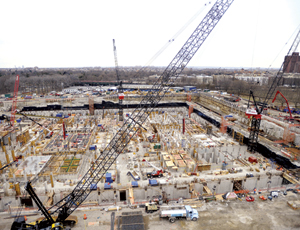Under an extremely tight deadline mandated by the U.S. Environmental Protection Agency, New York City is building its first-ever water filtration plant, which, once operational in 2012, will end a long, costly and often controversial saga that began nearly two decades ago.
Originally estimated at $992 million, the now $2.8-billion Croton Water Filtration Plant entailed more than 10 years of planning before contractors broke ground in early 2007. But unlike the breakneck, 51-month construction schedule, the idea for the 290-million-gallon-per-day plant has been slowly gestating in New York since 1989, the year EPA began requiring filtration for all surface drinking water.
“They talked about it for years,” says Bernard Daly, who is managing the project for the New York City Dept. of Environmental Protection. “Now we’re being very aggressive. It’s the driving part of the project.”
Enacted in 1989, the Surface Water Treatment Rule requires all public surface water systems to achieve 99.9% removal of bacteria, Giardia lamblia cysts and viruses and a maximum contaminant level of 1 nephelometric turbidity units. Like some other big cities that did not filter drinking water, New York City applied for and received a “filtration avoidance” for water that came from the Catskill/Delaware watershed, the western region of the city’s large 19-reservoir water system. But in 1993, EPA ordered the eastern portion of the system, the Croton watershed, be filtered and disinfected because of its consistent exposure to stormwater runoff and pollution. Construction of what now is estimated to be a $2.8 billion project—spread over 10 separate contracts—is expected to bring the Croton system up to EPA standards while supplying about 10% of the city’s drinking water under normal conditions and more than 30% during drought conditions. In all, the plant will have the capacity to treat 290 million gallons of water per day.
Located about 15 miles northeast of midtown Manhattan, the plant is being built between 80 ft and 100 ft underground across a 9-acre footprint at a golf course, located in the southeastern corner of Van Cortlandt Park in the Bronx. Raw water conveyed through the New Croton Aqueduct in Westchester County will enter the plant via gravity through an 865-ft, 12-ft-dia tunnel constructed as part of three-tunnel contract, which created one intake and two outflow lines by boring and blasting through more than a mile of hard rock. When complete, the plant will be covered with fill and replanted for use as a driving range.
The 400,000-sq-ft plant, designed under a $50-million contract by a joint venture of Metcalf and Eddy (now AECOM) and Hazen & Sawyer, both New York City, is divided into two identical but independent parallel treatment trains, each able to treat at least 50% of the plant’s capacity. Raw water will be boosted by four 55,400-gallon-per-minute vertical turbine pumps, which will propel it into three mixers that add coagulants and polymers to help remove solid particles. Sulfuric acid also is to be added for pH correction and sodium hypochlorite for disinfection.
Water will then move to 48 dissolved-air floatation tanks, 24 in each treatment train. The 22-ft-x-36-ft open-top concrete structures are stacked to reduce the size of the plant’s footprint. Flocculators force any coagulated solid particles to float to the top to be skimmed off before flow is sent through the filter.
“Stacking allowed us to effectively treat the water as well as maximize the space we had,” Daly says.
Filtered water will pass through a sand-and-charcoal media on its way to 20 ultraviolet treatment units for disinfection. After a final mixture of chemicals is added at each train’s final water weir—including hydrofluosilicic acid to prevent tooth decay and sodium hydroxide for additional pH adjustment—treated water will be discharged through two 108-in.-dia outflow tunnels, leading to the Jerome Park reservoir for distribution.
The Metcalf and Eddy/Hazen & Sawyer team designed a beefed-up, cast-in-place reinforced-concrete structure that was required to be flexible enough to be folded into a relatively small site and strong enough to support...





















Post a comment to this article
Report Abusive Comment